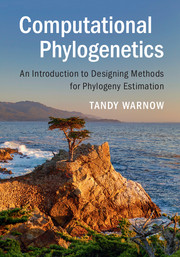Book contents
- Frontmatter
- Dedication
- Contents
- Preface
- Glossary
- Notation
- PART I BASIC TECHNIQUES
- 1 Brief Introduction to Phylogenetic Estimation
- 2 Trees
- 3 Constructing Trees from True Subtrees
- 4 Constructing Trees from Qualitative Characters
- 5 Distance-based Tree Estimation Methods
- 6 Consensus and Agreement Trees
- 7 Supertrees
- PART II MOLECULAR PHYLOGENETICS
- Appendix A Primer on Biological Data and Evolution
- Appendix B Algorithm Design and Analysis
- Appendix C Guidelines forWriting Papers About Computational Methods
- Appendix D Projects
- References
- Index
6 - Consensus and Agreement Trees
from PART I - BASIC TECHNIQUES
Published online by Cambridge University Press: 26 October 2017
- Frontmatter
- Dedication
- Contents
- Preface
- Glossary
- Notation
- PART I BASIC TECHNIQUES
- 1 Brief Introduction to Phylogenetic Estimation
- 2 Trees
- 3 Constructing Trees from True Subtrees
- 4 Constructing Trees from Qualitative Characters
- 5 Distance-based Tree Estimation Methods
- 6 Consensus and Agreement Trees
- 7 Supertrees
- PART II MOLECULAR PHYLOGENETICS
- Appendix A Primer on Biological Data and Evolution
- Appendix B Algorithm Design and Analysis
- Appendix C Guidelines forWriting Papers About Computational Methods
- Appendix D Projects
- References
- Index
Summary
Introduction
In this chapter we discuss techniques for analyzing sets of trees, which are called profiles. Depending on how the set of trees was computed and the objective of the analysis, different techniques are needed.
For example, when a maximum parsimony analysis is performed, many equally good trees may be found, all having the same “best” score (meaning that it is the best score found during the analysis). Similarly, when a Bayesian MCMC (see Section 8.7) analysis is performed, then a random sample of the trees is examined. Sometimes, many different types of methods are used on the same data, and for each analysis a set of trees is obtained. Then, from the full set of trees, each of which has been estimated on the same data, again some kind of point estimate is sought. In each of these cases, a “consensus method” is used to provide a point estimate of the tree from the full set of trees.
An alternative objective might be to find those subsets of the taxon set on which all or most of the trees in the profile agree; this kind of approach does not produce a point estimate of the true tree, but can be used to identify the portion of the history on which all trees agree, and also (potentially) problematic taxa. We refer to this type of approach as an “agreement method.”
In this chapter, we discuss consensus and agreement methods, which are methods for analyzing datasets of trees under the assumption that all the trees are estimated species trees with the same leafset S. We discuss supertree methods in Chapter 7, which extend the consensus methods in this chapter to allow for the taxon sets to be different between trees. Finally, methods for analyzing sets of gene trees that can differ from each other due to incomplete lineage sorting, horizontal gene transfer, or gene duplication and loss are discussed in Chapter 10. Many of the methods described in Chapter 10 can also be used as supertree methods.
Consensus Trees
In general, consensus methods are applied to unrooted trees (and we will define them in that context), but they can be modified so as to be applicable to rooted trees as well.
- Type
- Chapter
- Information
- Computational PhylogeneticsAn Introduction to Designing Methods for Phylogeny Estimation, pp. 109 - 120Publisher: Cambridge University PressPrint publication year: 2017



